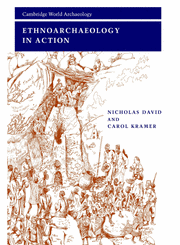Book contents
- Frontmatter
- Dedication
- Contents
- List of figures and credits
- List of tables
- Preface
- Acknowledgments
- Map
- 1 Ethnoarchaeology: its nature, origins, and history
- 2 Theorizing ethnoarchaeology and analogy
- 3 Fieldwork and ethics
- 4 Human residues: entering the archaeological context
- 5 Fauna and subsistence
- 6 Studying artifacts: functions, operating sequences, taxonomy
- 7 Style and the marking of boundaries: contrasting regional studies
- 8 Settlement: systems and patterns
- 9 Site structures and activities
- 10 Architecture
- 11 Specialist craft production and apprenticeship
- 12 Trade and exchange
- 13 Mortuary practices, status, ideology, and systems of thought
- 14 Conclusions: ethnoarchaeology in context
- Bibliography
- Index
7 - Style and the marking of boundaries: contrasting regional studies
Published online by Cambridge University Press: 05 March 2015
- Frontmatter
- Dedication
- Contents
- List of figures and credits
- List of tables
- Preface
- Acknowledgments
- Map
- 1 Ethnoarchaeology: its nature, origins, and history
- 2 Theorizing ethnoarchaeology and analogy
- 3 Fieldwork and ethics
- 4 Human residues: entering the archaeological context
- 5 Fauna and subsistence
- 6 Studying artifacts: functions, operating sequences, taxonomy
- 7 Style and the marking of boundaries: contrasting regional studies
- 8 Settlement: systems and patterns
- 9 Site structures and activities
- 10 Architecture
- 11 Specialist craft production and apprenticeship
- 12 Trade and exchange
- 13 Mortuary practices, status, ideology, and systems of thought
- 14 Conclusions: ethnoarchaeology in context
- Bibliography
- Index
Summary
The concept of style is a bad concept, as it is commonly used by archaeologists.
(Lewis Binford 1986: 561)Without style we have little or nothing to say.
(Margaret Conkey and Christine Hastorf 1990b: 2)… we remain a thousand leagues from a theory of material culture as an ensemble of signifying traits.
(Pierre Lemonnier 1986: 173)This lengthy chapter is divisible into two parts. In the first we tackle the definition of style and discuss where it resides, how it is produced, its function as a medium of information exchange, and its behavioral basis. In the second, we present critical analyses of four studies of manifestations of stylistic behavior on scales greater than that of a single community, three of which are genuinely regional in their scope. Why devote what might seem disproportionate space to this topic? Because there would be no archaeology if archaeologists did not regard the form of artifacts as in some manner informing on the culture that produced them. In 1912 when the Abbé Breuil (1913) delivered his classic address he relied on morphological differences in a variety of bone and stone tool types to distinguish cultural subdivisions of the European upper paleolithic and as a basis for inferring their evolutionary relationships. A characteristic European neolithic decorative tradition defines the “Linear Pottery culture,” and so on.
- Type
- Chapter
- Information
- Ethnoarchaeology in Action , pp. 168 - 224Publisher: Cambridge University PressPrint publication year: 2001

